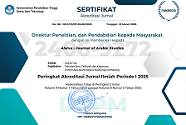Morfologi Bahasa Arab: Reformulasi Sistem Derivasi dan Infleksi
DOI:
https://doi.org/10.21580/alsina.1.1.2599Keywords:
Arabic linguistics, derivation, ‘ilm al-ṣarf, inflection, theory reformulationAbstract
Morphology, in the study of Arabic linguistics known as the discipline ‘ilm al-ṣarf, as part of grammar which examines the internal structure of words, has an urgency to be studied in depth. Especially in the context of Arabic studies that embrace typologies of complex inflective languages. This article examines the Arabic morphological system from a modern linguistic perspective, especially on derivational and inflectional changes. The discussion begins on the conception of derivation and inflection in the view of modern linguistics, as an introduction to see the system of derivation and inflection changes in Arabic linguistics. Morphological theories of Arabic grammars, in this article developed and communicated with modern linguistic theories. From this development a new formula was produced in the study of Arabic morphology which is expected to provide a more systematic description of the understanding of the Arabic morphological system.Downloads
References
Anderson, Stephen R. 1985. “Inflectional Morphology”. Lan-guage Typology and Syntactic Description: Grammatical Categories and the Lexicon. Vol. III. Cambridge: Cam-bridge University Press.
Ba‘albaki, Rohi. 1995. Al-Mawrid: A Modern Arabic English Dictionary. Beirut: Dār al-Ilmi li al-Malāyin.
Ba’dulu, Muis A. dan Herman. 2005. Morfosintaksis. Jakarta: Rineka Cipta.
Bauer, Lauire. 2001. Introducing Linguistic Morphology. Ed-inburgh: Edinburgh University Press.
Chaer, Abdul. 2008. Morfologi Bahasa Indonesia (Pendekatan Proses), Jakarta, Rineka Cipta.
Ghulāyainī al-, Musthafā. 1993. Jāmi’ ad-Durūs al-Arābiya. Beirut: al-Maktabah al-Ashriyah.
Hornby, A.S. 1995. Oxford Advanced Learner’s Dictionary. Oxford: Oxford University.
Jabal, Muhammad Hasan. 2005. ‘Ilm al-Isytiqāq: Nazhariyan wa Tathbīqiyan. Kairo: Maktabah al-Adāb.
Jinniy, Ibn. 1957. Al-Khashāish. Kairo: Dār al-Ilmiyah.
Nida, Eugene A. 1970. Morphology : The Descriptive Analysis of Words. Michigan: Ann Arbor The University of Mich-igan Press.
Parera, J.D. 2007. Morfologi Bahasa. Jakarta: Gramedia.
Pusat Bahasa. 2008. Kamus Besar Bahasa Indonesia. Jakarta: Departemen Pendidikan Nasional Republik Indonesia. http://pusatbaha¬sa.dik¬nas.go.id/kb¬¬bi/
Richards, Jack C. dan Schmidt, Richard. 2002. Longman Dic-tionary of Language Teaching and Applied Linguistics. London: Longman.
Robins, R.H. 1992. Linguistik Umum: Sebuah Pengantar. Yogyakarta: Kanisius.
Ryding, Karin C. 2005. A Reference Grammar of Modern Standard Arabic. Cambridge: Cambridge University Press.
Samsuri. 1982. Analisis Bahasa: Memahami Bahasa secara Ilmiah. Jakarta: Erlangga.
Schramm, Gene M. 1962. “An Outline of Classical Arabic Verb Structure”. Languge, Vol. 38, No. 4. USA: Linguistic Soci-ety of America. www.jstor.org. Wright 1981
Verhaar, J.W.M. 2008. Asas-asas Linguitik Umum. Yogyakarta: Gadjah Mada University Press.
Wehr, Hans. 1980. A Dictionary of Modern Written Arabic. Beirut: Librairie Du Liban.
Wright, William, LL.D. 1981. A Grammar of the Arabic Lan-guage. Cambridge: Cambridge University Press.
Downloads
Published
How to Cite
Issue
Section
License
Copyright
The copyright of the received article shall be assigned to the publisher of the journal. The intended copyright includes the right to publish the article in various forms (including reprints). The journal maintains the publishing rights to published articles. Authors are allowed to use their articles for any legal purposes deemed necessary without written permission from the journal, but with an acknowledgment to this journal of initial publication.
Licensing
In order for Alsina: Journal of Arabic Studies to publish and distribute research articles, the editors need publishing rights (transferred from author to publisher). This agreement relates to the transfer/publishing copyright license to Alsina: Journal of Arabic Studies but the authors still have significant rights to use and share their published articles.
Alsina: Journal of Arabic Studies supports the need for writers to share, disseminate and maximize the impact of their research and their rights on any database. As a journal article writer, you have the right to various uses of your articles, including that by the institution or company where you work. Copyright can be used without the need for special permission. Authors who publish articles in the Alsina: Journal of Arabic Studies have broad rights to use their work for teaching and scientific purposes without requesting permission, including:
- Use by the author for lectures, presentations, or conferences, with distribution of copies to participants;
- Distribution to colleagues for research use;
- Use in compilations of the author's subsequent work;
- inclusion in a thesis or dissertation;
- Reuse of sections or excerpts from articles in other works (with full acknowledgment of the final article);
- Preparation of derivative works (other than commercial purposes) (with full acknowledgment of the final article);
- Voluntary posting on open websites operated by authors’ or writers' agencies for scientific purposes
When submitting a manuscript, authors do so on the understanding that if accepted for publication, the copyright for publishing (publishing right) of the article shall be assigned/transferred to Alsina: Journal of Arabic Studies.
Authors whose articles are accepted for publication will receive confirmation via email and sent a Copyright Transfer Agreement.


 Accreditation
Accreditation 
 In Collaboration with
In Collaboration with 

 Visitors
Visitors  Article Template
Article Template





